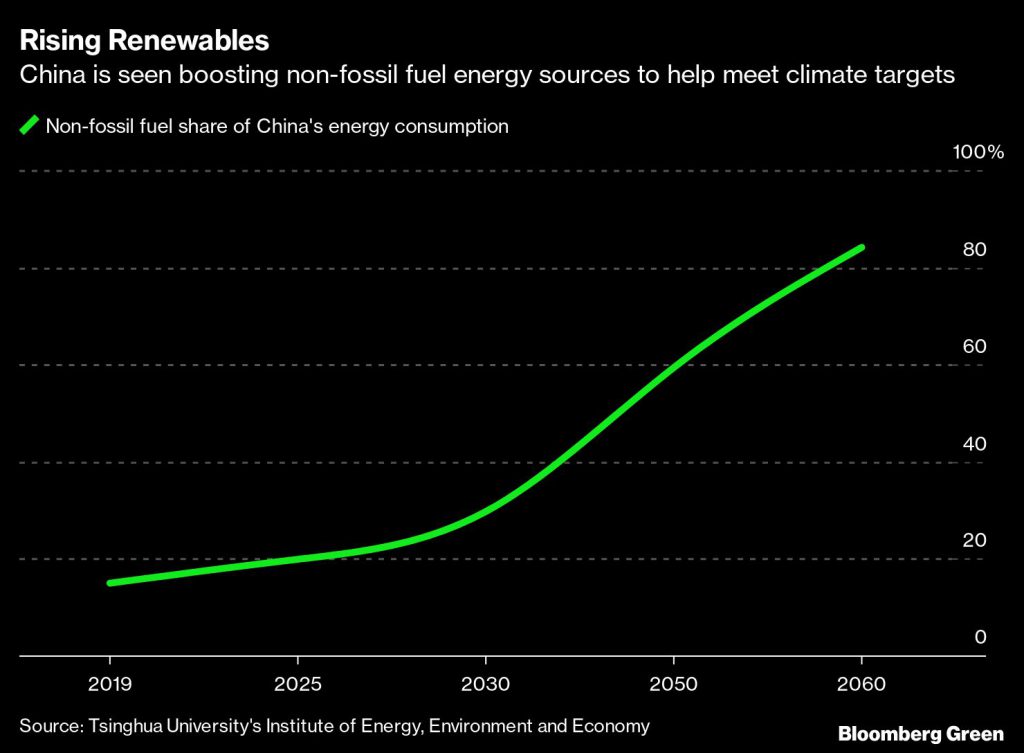China to phase out coal power around 2050

The most ambitious climate goal the world’s ever seen now has a road map for how to arrive at it.
One of China’s top climate research institutes on Sunday laid out a plan of increasing renewable and nuclear energy and completely phasing out coal power. It’s the first blueprint from a group that works closely with the government showing how the country might become carbon neutral by 2060, a goal laid out by President Xi Jinping last week in a speech to the United Nations.

The plan, from Tsinghua University’s Institute of Energy, Environment and Economy, entails a more gradual transition over the next decade and a half, with a rapid acceleration after 2035. The institute works closely with the Ministry of Ecology and Environment on projecting long term goals. It also works with a separate climate research institute at Tsinghua run by Xie Zhenhua, who led China’s climate policies and represented the country in international climate negotiations for more than 10 years.
Carbon emissions will peak sometime between 2025 and 2030, and total energy demand will start to decline around 2035, the institute’s director, Zhang Xiliang, said in a Sunday webinar. “We are trying to set the most cost-effective model to push every sector to realize the goal,” he said.
Under the plan, coal-fired electricity would be eliminated by 2050, and China’s energy mix would undergo a drastic transformation:
| Energy source | 2025 | 2060 | Percent change |
|---|---|---|---|
| Coal | 2.86 billion tons of coal equivalent | 110 million | -96% |
| Natural gas | 560 million | 140 million | -75% |
| Oil | 980 million | 340 million | -65% |
| Hydro | 440 million | 660 million | +50% |
| Biomass | 110 million | 220 million | +100% |
| Wind | 240 million | 1.07 billion | +346% |
| Nuclear | 170 million | 820 million | +382% |
| Solar | 150 million | 1.03 billion | +587% |
Investments needed to meet the 2060 target could total 100 trillion yuan ($15 trillion) over the next 30 years, He Jiankun, another Tsinghua researcher, said last week.
Power generation would nearly double from 2025 to about 16.4 terrawatt-hours in 2060, with electricity making up 80% of total energy consumption by 2060. Wind, solar and nuclear power will have to be boosted to offset the decline of dirty power as total electricity demand keeps increasing.
If realized, China’s nuclear power generation is set to quadruple between 2025 and 2060, which will probably mean enough plants to more than double the size of the U.S.’s current fleet, which is the world’s largest.
China would need to boost its share of non-fossil fuel energy to 20% by 2025, five years earlier than it planned. Chinese renewable energy companies have soared in the past few weeks on the possibility. Bloomberg News reported earlier that China is considering formalizing the target in its upcoming five-year plan.
The elimination of coal power would call into question dozens of power plants currently under construction. They would be rendered obsolete in 30 years, typically the time needed to recoup capital costs on them.
“While this proposal might get China to carbon neutrality by 2060, it would be better for the economy and the environment if emissions would decline more rapidly,” said Dimitri de Boer, China representative of ClientEarth, a European non-governmental organization focused on environmental law. “China has an opportunity now to boost the strategic sectors of the future, such as renewable energy, hydrogen, electric vehicles, green buildings, and smart grids.”
Some of the other key benchmarks Zhang laid out include:
- China’s carbon emissions are projected to rise from about 9.6 billion tons a year to 10.2 billion between 2025 and 2030.
- Emissions will fall to about 9 billion tons in 2035, and then will decline dramatically to 3 billion per year by 2050, 900 million by 2055 and 200 million by 2060.
- Energy demand will peak around 2035 at somewhere between 6 billion and 6.5 billion tons of coal equivalent.
- Coal-fired power will be phased out around 2050.
- The share of non-fossil fuels in total energy demand will grow from about 15% last year to 20% by 2025, 24% in 2030, 62% in 2050, and 84% in 2060.
- China will have to apply carbon capture and sequestration or bio-CCS to mitigate the remaining CO2.
More News
Trump planning to stockpile deep-sea minerals to counter China: FT
April 13, 2025 | 07:56 am
Goldman Sachs upgrades gold forecast again to $3,700
April 12, 2025 | 08:05 pm
{{ commodity.name }}
{{ post.title }}
{{ post.date }}




Comments